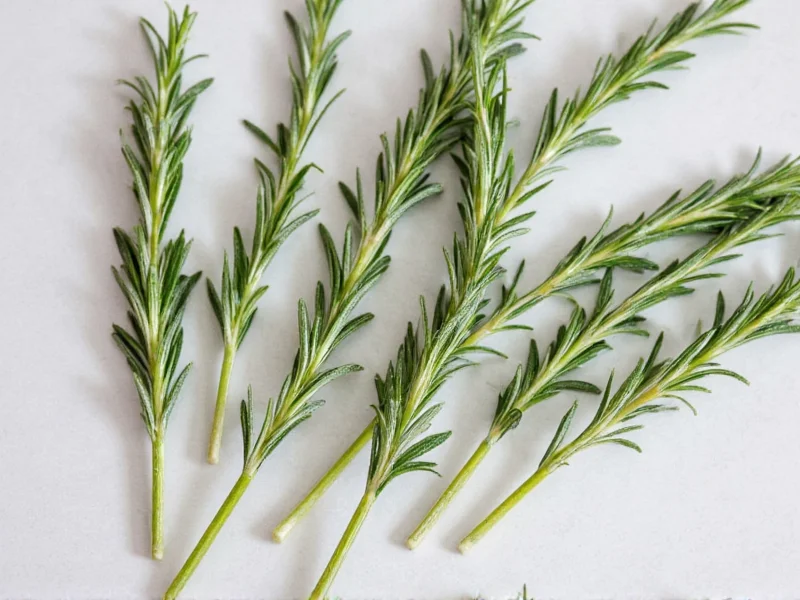The standard conversion ratio for fresh to dry rosemary is 3:1. This means 1 tablespoon of fresh rosemary equals 1 teaspoon of dried rosemary. The difference exists because dried rosemary has lost its water content, concentrating the flavor compounds. Understanding this fresh rosemary to dried conversion ratio ensures your recipes maintain proper flavor balance whether using fresh or dried herbs.
When cooking with rosemary, knowing the precise fresh to dry rosemary conversion can make the difference between a perfectly seasoned dish and one that's overpowering or bland. This essential kitchen knowledge applies whether you're following a family recipe, adapting a chef's instructions, or improvising with what's available in your pantry.
Why the 3:1 Fresh to Dry Rosemary Conversion Ratio Matters
Rosemary, like other herbs, undergoes significant chemical changes during the drying process. Fresh rosemary contains approximately 80-85% water, while dried rosemary has only about 10-15% moisture content. This water loss concentrates the essential oils and flavor compounds, making dried rosemary significantly more potent than its fresh counterpart.
The 3:1 ratio (3 parts fresh to 1 part dried) isn't arbitrary—it's based on extensive culinary testing and chemical analysis of herb potency. When you substitute without adjusting measurements, you risk creating dishes that are either under-seasoned or overwhelmingly herbal.
Complete Fresh Rosemary to Dried Conversion Chart
| Measurement | Fresh Rosemary | Dried Rosemary |
|---|---|---|
| Teaspoon | 3 teaspoons | 1 teaspoon |
| Tablespoon | 1 tablespoon | 1 teaspoon |
| Cup | 3 tablespoons | 1 tablespoon |
| Ounce by weight | 1 ounce | ⅓ ounce |
Practical Cooking Applications
Understanding fresh vs dried rosemary measurement becomes crucial when adapting recipes. Consider these real kitchen scenarios:
- Roast chicken recipe calling for 2 tablespoons fresh rosemary: Use 2 teaspoons dried rosemary instead
- Homemade bread recipe requiring 1 tablespoon dried rosemary: Substitute with 3 tablespoons fresh rosemary
- Pasta sauce needing 1 teaspoon dried rosemary: Replace with 1 tablespoon fresh rosemary, finely chopped
When substituting dried for fresh rosemary in long-cooking dishes like stews or braises, add the dried herb earlier in the cooking process to allow time for rehydration and flavor release. For fresh to dried conversion in quick-cooking dishes, add the dried herb near the beginning of cooking.
Quality Considerations in Rosemary Conversion
Not all dried rosemary is created equal. The age and storage conditions significantly impact potency:
- Fresh rosemary should be vibrant green with no brown spots and have a strong, pine-like aroma
- High-quality dried rosemary retains its green color (not brown) and still emits a noticeable fragrance when crushed
- Dried rosemary older than 6 months may have lost significant potency, requiring slight measurement adjustments
When working with older dried rosemary, you might need to increase the amount by 25-50% to achieve equivalent flavor to fresh. Always smell your dried herbs before using them—weak aroma indicates diminished potency.
Storage Tips for Maximum Flavor Retention
Proper storage affects how accurately the fresh to dry rosemary conversion ratio applies:
- Fresh rosemary: Store upright in a glass with water (like flowers) in the refrigerator, covered with a plastic bag. Lasts 2-3 weeks.
- Dried rosemary: Keep in an airtight container away from light and heat. Properly stored, it maintains peak potency for 6-12 months.
Freezing fresh rosemary in olive oil (1 sprig per cube) preserves flavor better than drying for some applications. When using frozen rosemary, treat it as fresh for conversion purposes.
Common Conversion Mistakes to Avoid
Many home cooks make these errors when substituting fresh and dried rosemary:
- Using equal measurements (1:1 ratio) instead of the proper 3:1 fresh to dry rosemary conversion
- Not adjusting for the age of dried herbs (older = less potent)
- Adding dried rosemary too late in the cooking process for quick dishes
- Using whole dried rosemary leaves instead of crushing them to release flavor
Remember that rosemary's flavor intensifies as it cooks. When substituting dried for fresh in long-simmering dishes, you might actually use slightly less than the standard conversion to prevent overpowering the dish.
Special Considerations for Different Rosemary Varieties
While the 3:1 ratio generally applies across varieties, some specialty types have different potency levels:
- Tuscan blue rosemary: Slightly more potent than standard varieties—use 2.5:1 ratio
- Prostrate rosemary: Milder flavor—use closer to 3.5:1 ratio
- Lavender-scented rosemary: Similar potency to standard—maintain 3:1 ratio
When working with homegrown or farmers' market rosemary, taste a small piece first to gauge its intensity before committing to a full conversion.











 浙公网安备
33010002000092号
浙公网安备
33010002000092号 浙B2-20120091-4
浙B2-20120091-4